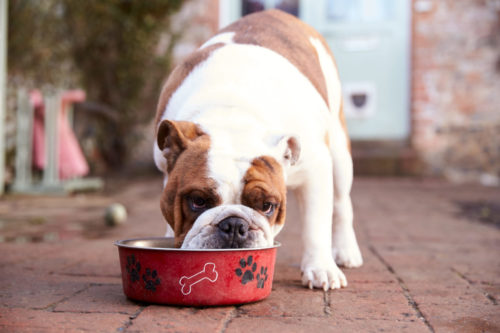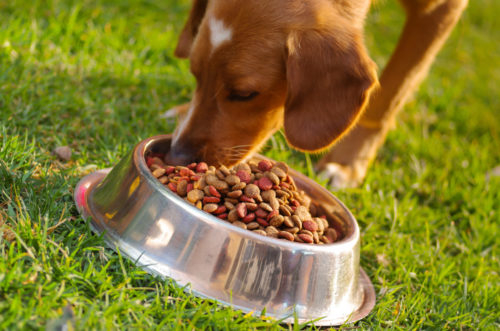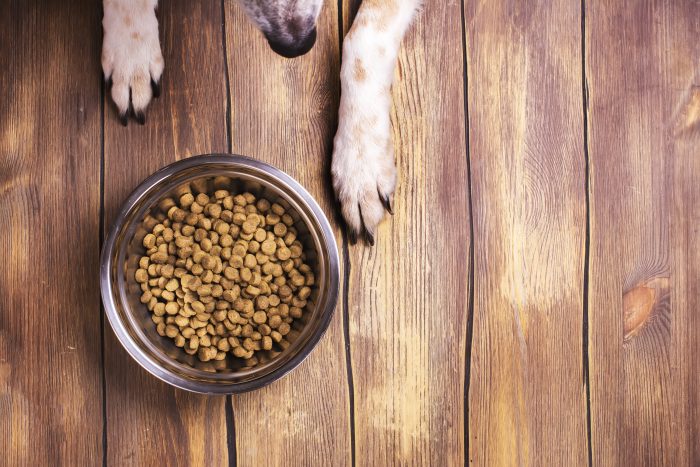We all want the very best for our four-legged companions. It is only natural for a dog owner to try and keep their pet in the best shape possible through their canine nutrition. Since your dog depends on you for meals and exercise, his overall health and well-being will be highly influenced by how you care for them. That’s why it is imperative that you do everything in your power to give him the proper diet and exercise he deserves.
One of the main components that contribute to a healthy dog is his diet. Keep in mind that not all dog foods are created equally, which means some products can be filled with harmful ingredients that in turn do more harm than good. Just like in the human body, the quality of food consumed will have a direct effect on our pet’s health as well. When shopping for a dog food product, it is crucial that you choose one with wholesome, natural, and nutritious ingredients.
By law, the Association of American Feed Control Officials (AAFCO) sets specific guidelines that require companies to have outlined standards when creating their dog food. That way animals are at least getting the minimum requirements of nutrients they need to sustain healthy body functioning. However, with that being said, certain dog food products may be better than others depending on your specific dog.
Since it can be difficult to know exactly what components should be included in your dog’s diet, here is a guide that outlines a dog’s required nutritional intake. This article will specify what ingredients should be added in your dog’s diet and how to follow a dog nutrition checklist when shopping for a food product. By following this guideline, you will be able to find the best food to help your dog live a long and healthy life. As you go through this guide, keep in mind that every dog is different and therefore requires different needs. The best way to ensure you are feeding your dog a healthy diet is by talking with your vet.
What Should Be Included In Your Dog’s Diet?

Carbohydrates
One of a dog’s primary sources of energy is through carbohydrates. While carbohydrates should be combined with protein to create a balanced diet, it should not be a component that is avoided. Aside from being an energy source, carbs also work to regulate blood pressure and can add a source of fiber to help with digestion. Carbohydrates can be included in many different forms such as wheat, corn, oats, or rice.
To see which carbs are including in your dog’s food, all you have to do is look at the back of the bag. As a rule of thumb, always look for whole grains or other nutritious sources. On average, a dog’s diet should include between 30-70% of carbohydrates. This amount may vary depending on the dog’s age, size, activity level, and metabolism.
Protein
After the carbohydrates come protein. The protein contains amino acids, which work to restore and strengthen muscles and also repair tissue. These amino acids are critical for any animal’s diet and are essential components that help strengthen the immune system as well. When it comes to the protein within your dog’s food, look for a natural source. It is always a good idea to stay away from ingredients you don’t know.
Try to find a common protein that is easy to identify such as chicken, beef, turkey, fish or eggs. Just like with humans, the more natural the ingredient, the better. Dogs should have 18-25% of protein in their diet. Beware of products that contain high levels of protein, for too much can actually be harmful to the body.
Fats and Oils
Fats and oils are critical components that need to be in your dog’s diet. While too much fat is never a good thing, a small amount can actually help absorb certain vitamins. It also can be used as an energy source in a moderate amount. Another major benefit of adding fat to a dog’s diet is it promotes healthy skin and coat health.
Potential fat sources that can be used in your dog’s food includes fish oil, chicken fat, soybean oil, pork fat, and many others. Generally, a dog should consume 10-15% fat in their diets to maintain a healthy body. Just be careful that your pet’s fat consumption does not go over this amount, which can cause them to gain weight and be susceptible to canine obesity.
Vitamins and Minerals
Essential vitamins and minerals are an important factor that is needed in every diet. There is a wide range of different vitamins and minerals that are required to support various body functions. For example, vitamin A helps promote a healthy coat while vitamin C helps to reduce inflammation. Most of a dogs vitamin intake comes from fruits, vegetables, and meats that are included in dog food. Common minerals that should also be in your dog’s food should consist of calcium, potassium, sulfur, magnesium, sodium, and phosphorus. If your dog food is labeled as a “balanced diet,” that usually means these components are already included in the mix.
Water
Last but certainly not least, water is a critical component that is essential for every dog’s diet. Water offers endless benefits from waste elimination, to mineral transportation, and even helps cell functioning as well. Water is also essential for lubricating joints, the spinal cord, and tissue. If a dog does not get enough water into his daily routine, he can quickly become dehydrating, causing other unfavorable symptoms to surface.
In order to make sure your dog is drinking enough water on a daily basis, move his water bowl in an easily accessible place that is in a central location of the house. It is also important to make sure his water bowl is cleaned daily and filled with fresh water as often as needed. As a general rule of thumb, dogs should consume one ounce of water for every pound of body weight. Now, this may vary if the dog is in a hot environment or has been working out excessively.
Difference Between Wet Food and Dry Food
So now that you’ve learned which food should be included in your dog’s diet, it’s time to decide what type of food is best for your specific companion. As most people already know, there are two primary types of dog food on the market: wet and dry. Before going into specifics, please note that both options are good for dogs. What it really comes down to is the quality of ingredients that are present in the products. If you are confused on which one would be best for your pup, talk to your veterinarian for specific recommendations. Every dog is unique with different preferences, dislikes, and level of health.
When it comes to wet food, most vets will recommend this variety if a dog is reluctant to drink water. Wet food is also recommended for older dogs who are struggling with their sense of smell. This product has a stronger odor, therefore making a dog more interested in eating the food. In some cases, wet food may just be the easier option to consume, especially if the dog has a small jaw or missing teeth. The main drawback to feeding your dog wet food is that they will be more prone to developing dental issues later on in life. Studies show canines who consume wet food are more susceptible to dental disease.
Dry food, on the other hand, is known for it’s convenient and affordable qualities. Unlike wet food, dry kibble can be left out without refrigeration and still be good to eat. All you need to do is keep the kibble in an airtight bin with a lid, that way no insects or rodents can make their way inside. Aside from being very convenient, dry food is also more cost efficient, especially if you are feeding multiple pets. It is also better for your pet’s teeth; some dry food is even shaped to clean your dog’s teeth while they chew. The major disadvantage to dry food is the lack of moisture within the product. If your dog eats kibble, make sure he is still consuming a sufficient amount of water on a regular basis. You should also verify that your dog’s dry food contains wholesome and natural ingredients. Talk to your vet about a recommended product that’s safe for your loving companion.
How to Boost Your Dog’s Diet
Now that you know what ingredients to look for and the type of food your dog needs, its time to pick a product! Below are some helpful rules to follow while shopping for your pet’s food. As always, if you are still unsure of what fits best for your pet, consult with your veterinarian for recommendations.
Ignore the hype
We’ve all seen it: leading dog food companies are all over the tv labeling themselves as the “most nutritious” pet food product that’s the best option for every dog. Unfortunately, some of the biggest companies are far from healthy, only portraying this false facade to deceive you. Don’t fall into these traps just because you’ve seen an advertisement. The best way to avoid this is to read the label and see what type of ingredients are in the food product. Is there the recommended amount of carbs, proteins, fats, vitamins, and minerals? Are there ingredients that you don’t recognize? These are the main components you should be looking out for when reading your dog’s food label. Just like on regular food labels, dog foods will list the ingredients from largest amount to smallest going from top to bottom.
Switch It Up With Fresh Ingredients
To add some versatility to your dog’s diet, try cooking them a fresh meal yourself. Certain vegetables and fruits can be given to your dog for extra nutrients. Cooked salmon, pork, tuna or other proteins can be very nutritious for your pet. You can also add some extra flavor and nutrients by boiling some potato or carrots. For carbs, you can feed them cooked white rice or another type of grain. Before feeding your dog any human food, make sure to verify it is safe with your vet. While some natural food can be very beneficial to your dog, there are also a number of others that should be stayed away from.
Stick to The Recommended Amount
Wondering why your dog has gained a few extra pounds? It could be because he is eating more than he should. Although it may be hard to turn down those big puppy eyes when your pup is looking for his afternoon snack, try to refrain. Even if you are feeding him the healthiest dog food, he can still develop obesity if he is being fed too much. In order to find out how much your specific dog needs, talk to your vet for further recommendations. Your vet will factor in your dog’s weight, age, and activity level before coming up with his recommended amount.
Wrapping Up
If you want to give your dog the best life possible, set them up for success by feeding them a wholesome and nutritious diet. With so many products on the market, it can be hard to decipher the good from the bad. To make the process simpler, check the labels for protein, carbs, fats, vitamins, and minerals. These components should be within the set percentages listed above. If the product contains unnatural or even harmful ingredients, opt out for a different product.
At the end of the day, the best resource for finding the right dog food will be your vet. Your vet is there to guide you on any questions regarding your dog’s overall health, so make sure to ask them anytime you feel uncertain. As long as you provide your dog with nutritious food, daily walks, and plenty of attention, he will be able to live happily and healthily.





